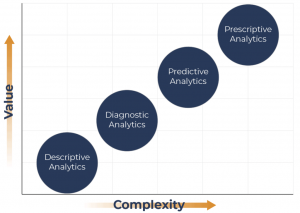 Descriptive vs. Predictive Analytics
Descriptive vs. Predictive Analytics
Generally, data analysis can be seen as the process of asking and answering complex questions to better understand data sets. This process can be useful in business, as it allows greater insights into the operations of the business, especially in analyzing trends and effectiveness of initiatives. Descriptive analytics, specifically, allows a business to see outcomes of events, and visualize trends in data. Descriptive analytics works well for the present or past time frame. One example from Google Analytics of descriptive analytics is data regarding the number of sessions per user on a website in a given month. Predictive analytics, on the other hand, refers to data which can be used to make predictions about what may happen in the future. Predictive analytics work in tandem with descriptive analytics, which form a basis for these predictions. One example of predictive analytics would be an inference of how many sessions per user a website might experience in the next month based on previous months’ data. As seen in the picture above, the four levels of analytics work together as they increase in complexity. While one could employ descriptive analytics without predictive analytics, the reverse would not be true.
Hi Julia,
I gained a lot of insight from reading your post. I really like how you broke down the meaning of both descriptive and predictive analytics and provided examples for both. Whenever I think of descriptive analytics, I like to think of business intelligence. BI will analyze past data to create dashboards, charts, etc. to visualize the findings. Whenever I think of predictive analytics, I like to think of business analytics. According to our reading this week, business analytics focuses on predicting the future. Also, not only did you provide great examples, but I also think you found an excellent image to add as well. It gives a good visual to everything you wrote about. Overall, I think this is an excellent post!